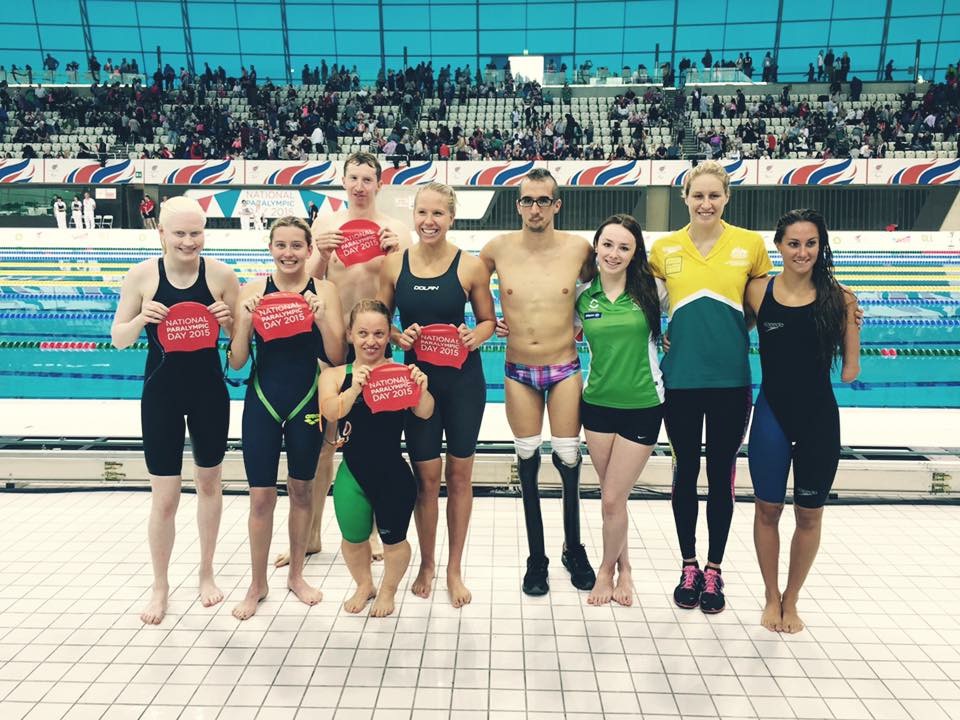It’s show time! Paralympic Trials begin this week, and Rio is right around the corner. If you want to dive into the Paralympic swimming action this summer but are a little confused about how to follow along, here’s your crash course in my sport. Most aspects of para-swimming are the same as able-bodied swimming, but there are a few important differences.
Classification: Classification is different for each Paralympic sport. In swimming, there are 14 classes, each beginning with an “S” to signify “swimming.” When athletes first get involved in Paralympics, they undergo a series of tests to measure the function of their muscles, range of motion, limb length, etc. and are assigned a class based on the results. To ensure a fair playing field, we only compete against swimmers in the same class. It’s just you and your suit in the water – no prosthetics or braces allowed!
Classes S1-S10 are for athletes with physical impairments; S1 is the most severe, while S10 is the most mild. An S1 athlete may have no arms or legs, for example, while an S10 athlete may have mild cerebral palsy or a below-knee amputation. Because of the weakness in my left leg and fusions of my spine and heel bone, I’m an S9. Most of the other swimmers in this category are below-elbow amputees or above-knee amputees.
Classes S11-S13 are for visually impaired swimmers. S11 swimmers are completely blind, and have to compete with blacked-out goggles! How do they know when they’re reached the wall? A coach, or ‘tapper,’ stands in front of their lane and taps them on the head with a long stick before they need to turn or finish the race. S12 and S13 swimmers are legally blind but have some vision, and usually do not use a tapper.
The S14 class is for swimmers with intellectual impairments. In case all this wasn’t confusing enough, there are different classes for different strokes! The “S” means that class is valid for freestyle, backstroke, and butterfly events. “SB” means the class is valid for breaststroke, and “SM” is for medley, or IM. Most swimmers are the same class for S and SM, but many swimmers with a leg impairment, including myself, go down a class for breaststroke, because it is such a leg-intensive stroke.
Events: While Paralympic and Olympic swimming share many of the same events, there are a few that are unique to each. In Paralympic swimming, swimmers in classes S1-S7 generally swim shorter events, while the higher classes swim longer events. For example, S1-S5 swimmers compete in the 200 freestyle and 50’s of strokes, while higher classes swim the 400 freestyle and 100’s of stroke. There is even a 150 meter Individual Medley – no butterfly! Olympic swimming has longer events like the 800 and the 1500, and 200’s of strokes.
Relays: My favorite part of swimming! To make relays fair for all countries, the classifications of the four swimmers on the relay must add up to a certain number of points. I swim on a 34 point relay, so the relay can have any combination of four swimmers that add up to 34 points. There’s a 20 point relay as well. I think this makes Paralympic relays even more exciting than Olympic relays, because the lead changes so much depending on the order of the swimmers!
Rules: If you are a die-hard swim fan watching the Paralympics, you may notice a few things that would get a swimmer disqualified in an able-bodied competition. In butterfly and breaststroke, for example, able-bodied swimmers always have to touch the wall with two hands, but if you’re a para-swimmer who is missing a hand or arm, you have an ‘exception’ to this rule. Swimmers with no arms at all can finish head-first! Also, swimmers who have trouble balancing on the blocks are allowed to have a coach ‘assist’ them by holding them up on the blocks before they dive in.
Paralympic Trials are held June 29-July 2 in Charlotte, NC. I’ll be swimming the 50 free on July 1, and the 100 free on July 2. The Rio team is officially announced on July 3! I’ll be posting updates on Twitter and Instagram if you want to follow along. Go Team USA!
‘Road to Rio’ is a monthly blog series written by Paralympic swimmer and former Magee patient Michelle Konkoly as she prepares for the 2016 Paralympic Games in Rio de Janeiro, Brazil.





